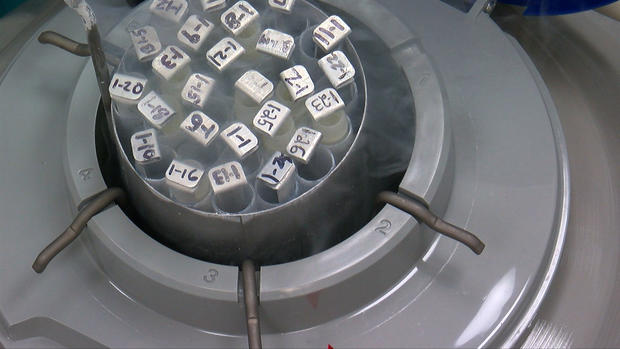Who Is Monitoring Minnesota's Fertility Clinics?
MINNEAPOLIS (WCCO) -- Families are mourning the loss of their future children after freezer malfunctions at Ohio and San Francisco fertility clinics this spring.
The failures have sent shockwaves across the industry, and had us questioning the standards at Minnesota's fertility clinics.
WCCO found a system separate from government oversight.
Sarah Goodman knew early on that starting a family would not be easy.
"As long as I can remember, I didn't want to go to school or be this, or be that. I like just wanted to be a mom," Goodman said.
She was diagnosed with conditions affecting her uterus and ovaries as a teenager.
"It's a hard, long journey, it's draining, it's tiring," she said.
Once she got married, visits to a fertility clinic became a regular part of her week.
"It was about eight months there with tests, treatments, medications, tracking," she said.
They finally had success with what is known as intrauterine insemination, or IUI.
The treatment gave the Goodman's Creu and Lakely. But, as they try to be a family of five, they are not seeing the same result.
"The third kid, it's just been two years too long, or so we feel," Goodman said.
The Goodmans are now trying the much more costly option of in vitro fertilization.
As they grapple with new questions many Minnesota families are asking after the heartbreaking loss suffered in two states.
In Ohio, a temperature fluctuation on a storage tank meant 4,000 frozen eggs and embryos were lost.
Coincidentally, on the same day, 2,000 miles away in San Francisco, a tank by a different manufacturer failed shattering the dreams of hundreds of families.
Dr. April Batcheller, the Medical Director of Colorado Center for Reproductive Medicine in Edina, has been fielding calls about tank storage ever since.
"Certainly an unexpected and tragic event for all parties," Batcheller said. "Cryopreservation of sperm, eggs and embryos is really paramount to what we do."
CCRM allowed WCCO behind the scenes of its endocrinology lab to see what goes into keeping reproductive cells and embryos safe.
They are preserved in a tank of liquid nitrogen at minus 200 degrees.
Every day the oxygen sensor is checked, along with the temperature of each tank.
Liquid nitrogen levels are checked weekly. A remote alarm on every tank monitors conditions around the clock. If it detects trouble, an alarm sounds, and emails and texts are sent to staff.
That alarm requires someone to physically pick it up to shut it off. In the Ohio case, that safeguard failed.
WCCO found no one really knows how common storage mistakes are. There is no agency tracking them and no real regulations.
Instead, fertility clinics follow guidelines. The American Society for Reproductive Medicine sets best practices for things like record-keeping and equipment failures. Those failures at two clinics have renewed the call for better government oversight.
"Ensuring that its safe and efficacious is obviously critical," Batcheller said.
She is confident in the systems CCRM already has in place. It has never had a storage problem.
"It's really an amazing opportunity to help people who otherwise couldn't have a family," Batcheller said.
Couples like the Goodmans, who have spent countless hours and nearly $80,000 to get theirs.
"It's a high, high priority for us, and we just know that we're not done," Goodman said.
The Centers for Disease Control requires clinics to report basic details of treatment cycles like outcomes, and the number of embryos transferred.
The United States Food and Drug Administration is also involved, but only in testing for diseases so labels do not get mixed up.




